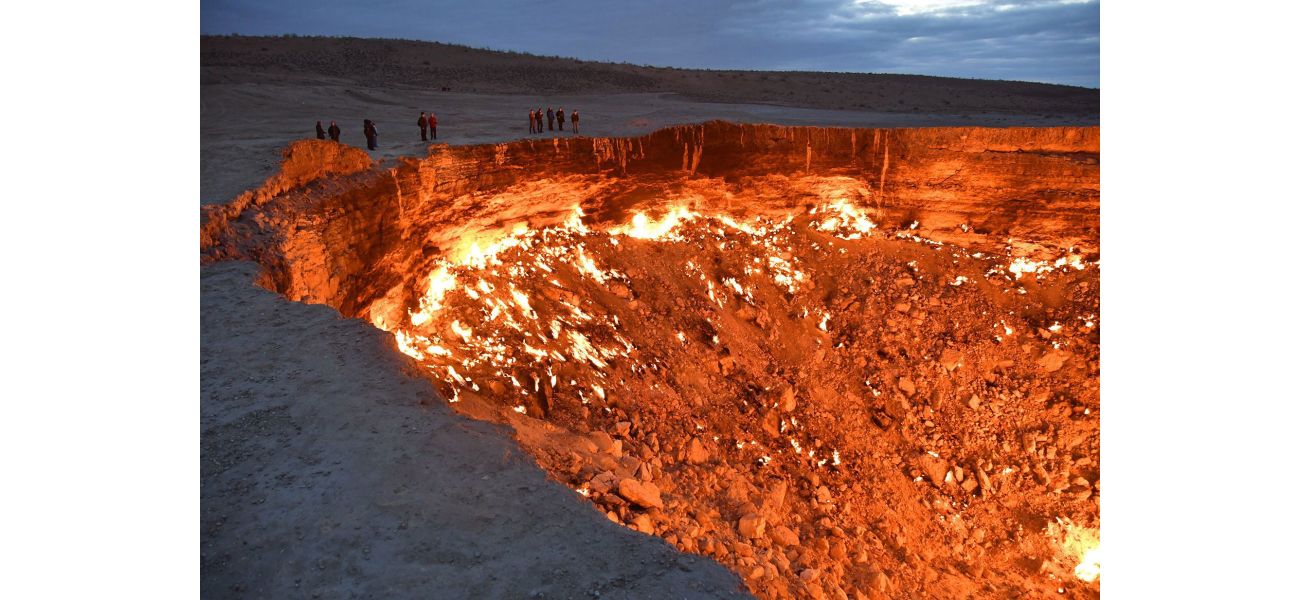Explore the enigmatic and fiery 'Gates of Hell' that exist in our world.
Uncommonly, an industrial mishap turns into a popular tourist spot.
September 7th 2024.

It's not every day that a workplace mishap turns into a popular tourist attraction. But that's exactly what happened when a team from the Soviet Union went looking for natural gas in Turkmenistan over half a century ago. The result? The Darvaza Gas Crater, a massive fiery pit that has become one of the most sought-after destinations in the country.
Known by many names such as the "Gates of Hell" and the "Shining of Karakum," this incredible phenomenon is caused by methane-fueled flames that shoot out from numerous vents on the crater's floor and walls. Standing at the edge of the crater, the intense heat radiating from below is almost palpable. And at night, when the fiery tongues are dancing under a starry sky, the sight is truly breathtaking.
Located in a remote part of the Karakum Desert, the crater is surrounded by sand dunes and rocky outcrops, making it the highlight of any tour of the Central Asian nation. In the early days, when tourists first started flocking to Darvaza, there were no visitor services or amenities, and people had to bring everything they needed for an overnight stay.
But now, things have changed. There are three permanent camps with yurts and tents for overnight accommodation, as well as meals and motorized transportation to the rim for those who prefer not to walk. The crater itself is about 70 meters wide and 30 meters deep, with steep vertical walls that drop sharply into a rocky debris field at the bottom. In 2018, a safety fence was installed to prevent visitors from getting too close to the blazing sinkhole.
Despite its eerie and mysterious origins, the Darvaza Gas Crater has become a must-visit destination for adventurous travelers. Author Ged Gillmore, who wrote about the crater in his book "Stans By Me: A Whirlwind Tour Through Central Asia," describes it as a "collapsed gas cave" that may not sound very interesting, but he also admits to feeling a sense of creepiness while standing at the edge of the crater.
However, the future of this natural wonder may be uncertain. The Turkmenistan government has mentioned the possibility of sealing the crater, and there are concerns that the flames are getting smaller and may eventually disappear. Dylan Lupine, who runs a travel company that was one of the first to bring tourists to Turkmenistan, has noticed a decrease in the size and number of flames over the years.
A local guide, who wishes to remain anonymous, confirms this trend, saying that the flames have been getting lower and lower over the last seven years. He speculates that this could be because the gas pocket is running out. But even with the diminishing flames, the Darvaza Gas Crater continues to enthrall visitors, especially when a sandstorm blankets the area, leaving only the flickering fire visible in the darkness.
The exact origins of the crater are shrouded in mystery and myth, as there are conflicting reports and missing information from the Soviet era. Canadian adventurer and TV presenter George Kourounis, who is the only person known to have explored inside the crater, says that there are various theories about when and how it formed. He even shares an interesting tidbit from his visit, where he was told by government geologists that the crater may have been bubbling with mud and gas for years before it was finally ignited in the 1980s. With so many stories and legends surrounding the Darvaza Gas Crater, it's no wonder that it has captured the imagination of travelers from all over the world.
It's not often that an industrial accident becomes a must-see destination, but that's exactly what happened with the Darvaza Gas Crater in Turkmenistan. It's hard to believe, but this massive fiery hole was created over 50 years ago by a Soviet team drilling for natural gas. The chain reaction they set off resulted in a breathtaking sight that has since become the country's most popular attraction.
Known by various names such as the "Gates of Hell" and the "Shining of Karakum," this phenomenon is caused by methane-fueled flames that escape from numerous vents scattered across the crater floor and walls. Standing at the rim, you can feel the intense heat radiating from the depths below. And at night, with the fiery tongues blazing under the starry sky, the scene is even more dramatic.
Located in a remote part of the Karakum Desert, the crater is surrounded by dunes and rocky outcrops, making it the highlight of any tour of Turkmenistan. However, when tourists first started flocking to Darvaza, there were no amenities or services available. Visitors had to bring everything they needed for an overnight stay. But now, there are three permanent camps with comfortable yurts and tents for overnight accommodation, as well as meals and motorized transportation for those who prefer not to walk.
The crater itself is approximately 70 meters wide and 130 meters deep, with vertical walls that drop sharply into a rocky debris field at the bottom. To ensure the safety of visitors, a fence was installed in 2018 to prevent anyone from getting too close to the blazing sinkhole. Author Ged Gillmore, who wrote about the crater in his book "Stans By Me: A Whirlwind Tour Through Central Asia," describes it as a "collapsed gas cave" that may not sound very interesting at first, but has an eerie and somewhat creepy feel to it.
However, this natural wonder may not be around for much longer in its fiery form. The Turkmenistan government has mentioned the possibility of sealing the crater, and there have been reports that the flames are much smaller now compared to when the crater was first discovered. Dylan Lupine, the founder of UK-based Lupine Travel, who was one of the first to bring tourists to the site, says that the flames are now only burning at about 40% of their original level.
Even the local guides, who have been visiting the crater for years, have noticed a decline in the flames. According to one guide, the flames used to be much larger, but now there are fewer and they are not as high. He believes that this may be because the gas pocket is running out.
But despite the dwindling flames, the Darvaza Gas Crater remains a mesmerizing sight, especially when a sandstorm rolls in and obscures everything except for the flickering fire reaching up from the dark pit below. Its mysterious origins only add to its allure, as the reports from the Soviet era are either missing, incomplete, or still confidential. Even Canadian adventurer and television presenter, George Kourounis, who is the only person known to have explored inside the crater, admits that there are multiple theories about how it was created.
Some believe that the crater formed in 1971 and was ignited shortly after, while others claim it formed in the 1960s and was burning for years before it was set on fire in the 1980s. With so many different stories and speculations about its origins, the Darvaza Gas Crater remains a fascinating and mystical wonder that continues to draw in curious visitors from all over the world.
Known by many names such as the "Gates of Hell" and the "Shining of Karakum," this incredible phenomenon is caused by methane-fueled flames that shoot out from numerous vents on the crater's floor and walls. Standing at the edge of the crater, the intense heat radiating from below is almost palpable. And at night, when the fiery tongues are dancing under a starry sky, the sight is truly breathtaking.
Located in a remote part of the Karakum Desert, the crater is surrounded by sand dunes and rocky outcrops, making it the highlight of any tour of the Central Asian nation. In the early days, when tourists first started flocking to Darvaza, there were no visitor services or amenities, and people had to bring everything they needed for an overnight stay.
But now, things have changed. There are three permanent camps with yurts and tents for overnight accommodation, as well as meals and motorized transportation to the rim for those who prefer not to walk. The crater itself is about 70 meters wide and 30 meters deep, with steep vertical walls that drop sharply into a rocky debris field at the bottom. In 2018, a safety fence was installed to prevent visitors from getting too close to the blazing sinkhole.
Despite its eerie and mysterious origins, the Darvaza Gas Crater has become a must-visit destination for adventurous travelers. Author Ged Gillmore, who wrote about the crater in his book "Stans By Me: A Whirlwind Tour Through Central Asia," describes it as a "collapsed gas cave" that may not sound very interesting, but he also admits to feeling a sense of creepiness while standing at the edge of the crater.
However, the future of this natural wonder may be uncertain. The Turkmenistan government has mentioned the possibility of sealing the crater, and there are concerns that the flames are getting smaller and may eventually disappear. Dylan Lupine, who runs a travel company that was one of the first to bring tourists to Turkmenistan, has noticed a decrease in the size and number of flames over the years.
A local guide, who wishes to remain anonymous, confirms this trend, saying that the flames have been getting lower and lower over the last seven years. He speculates that this could be because the gas pocket is running out. But even with the diminishing flames, the Darvaza Gas Crater continues to enthrall visitors, especially when a sandstorm blankets the area, leaving only the flickering fire visible in the darkness.
The exact origins of the crater are shrouded in mystery and myth, as there are conflicting reports and missing information from the Soviet era. Canadian adventurer and TV presenter George Kourounis, who is the only person known to have explored inside the crater, says that there are various theories about when and how it formed. He even shares an interesting tidbit from his visit, where he was told by government geologists that the crater may have been bubbling with mud and gas for years before it was finally ignited in the 1980s. With so many stories and legends surrounding the Darvaza Gas Crater, it's no wonder that it has captured the imagination of travelers from all over the world.
It's not often that an industrial accident becomes a must-see destination, but that's exactly what happened with the Darvaza Gas Crater in Turkmenistan. It's hard to believe, but this massive fiery hole was created over 50 years ago by a Soviet team drilling for natural gas. The chain reaction they set off resulted in a breathtaking sight that has since become the country's most popular attraction.
Known by various names such as the "Gates of Hell" and the "Shining of Karakum," this phenomenon is caused by methane-fueled flames that escape from numerous vents scattered across the crater floor and walls. Standing at the rim, you can feel the intense heat radiating from the depths below. And at night, with the fiery tongues blazing under the starry sky, the scene is even more dramatic.
Located in a remote part of the Karakum Desert, the crater is surrounded by dunes and rocky outcrops, making it the highlight of any tour of Turkmenistan. However, when tourists first started flocking to Darvaza, there were no amenities or services available. Visitors had to bring everything they needed for an overnight stay. But now, there are three permanent camps with comfortable yurts and tents for overnight accommodation, as well as meals and motorized transportation for those who prefer not to walk.
The crater itself is approximately 70 meters wide and 130 meters deep, with vertical walls that drop sharply into a rocky debris field at the bottom. To ensure the safety of visitors, a fence was installed in 2018 to prevent anyone from getting too close to the blazing sinkhole. Author Ged Gillmore, who wrote about the crater in his book "Stans By Me: A Whirlwind Tour Through Central Asia," describes it as a "collapsed gas cave" that may not sound very interesting at first, but has an eerie and somewhat creepy feel to it.
However, this natural wonder may not be around for much longer in its fiery form. The Turkmenistan government has mentioned the possibility of sealing the crater, and there have been reports that the flames are much smaller now compared to when the crater was first discovered. Dylan Lupine, the founder of UK-based Lupine Travel, who was one of the first to bring tourists to the site, says that the flames are now only burning at about 40% of their original level.
Even the local guides, who have been visiting the crater for years, have noticed a decline in the flames. According to one guide, the flames used to be much larger, but now there are fewer and they are not as high. He believes that this may be because the gas pocket is running out.
But despite the dwindling flames, the Darvaza Gas Crater remains a mesmerizing sight, especially when a sandstorm rolls in and obscures everything except for the flickering fire reaching up from the dark pit below. Its mysterious origins only add to its allure, as the reports from the Soviet era are either missing, incomplete, or still confidential. Even Canadian adventurer and television presenter, George Kourounis, who is the only person known to have explored inside the crater, admits that there are multiple theories about how it was created.
Some believe that the crater formed in 1971 and was ignited shortly after, while others claim it formed in the 1960s and was burning for years before it was set on fire in the 1980s. With so many different stories and speculations about its origins, the Darvaza Gas Crater remains a fascinating and mystical wonder that continues to draw in curious visitors from all over the world.
[This article has been trending online recently and has been generated with AI. Your feed is customized.]
[Generative AI is experimental.]
0
0
Submit Comment





